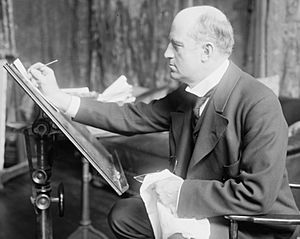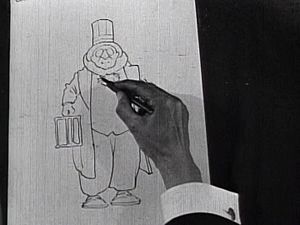Cartoonist facts for kids
A cartoonist is an artist who draws cartoons. These drawings can be for fun, to share ideas about politics, or for advertising. Cartoonists create many different types of art. This includes animation (moving pictures), comic strips (like in newspapers), comic books, and graphic novels (like long comic books). They also draw for editorial cartoons (about news), greeting cards, magazines, and newspapers.
Cartoons can be still pictures on a page, often called comics or comic strips. They can also be moving pictures, known as animation. You can find both kinds of cartoons online.
Contents
History of Cartoons
Early Western Cartoons
In the 1700s, an English artist named William Hogarth started drawing pictures that told stories. His art often made fun of politics and daily life. These types of drawings are sometimes called "Hogarthian."
Later in the 1700s, political cartoons became popular in England. Artists like James Gillray and Thomas Rowlandson used cartoons to make fun of kings, prime ministers, and generals. Gillray is often called the "father of the political cartoon."
In America, Benjamin Franklin drew what is thought to be the first cartoon published in an American newspaper. It was called "Join, or Die" (1754). Later, in the 1800s, cartoonists like Thomas Nast created famous American political symbols, such as the Republican elephant.
Modern Cartooning

In the 1900s, many magazines featured single-picture cartoons. These were often funny drawings called "gag cartoons." Newspapers also had syndicated single-panel cartoons. This means the same cartoon appeared in many different newspapers.
Comics and Their Creation
Comic strips are widely shared in newspapers by special companies called syndicates. These companies send the comic strips to many different newspapers. Sunday comic strips are often sent to a company that adds color before they are printed.
Some comic strip artists also publish their work online. Others create longer stories in book form, known as graphic novels. Old and new comic strips are often collected and reprinted in books.
Major comic book companies like Marvel and DC use teams of artists. One artist might draw the basic shapes (penciller). Another might go over the lines with ink (inker). Someone else adds the words (letterer), and a colorist adds the color digitally. To make sure characters look the same, artists often use "model sheets" as a guide.
A cartoonist is different from an illustrator. A cartoonist usually creates both the ideas and the drawings. An illustrator often draws pictures for someone else's ideas or stories.
Types of Animation
Animated cartoons are made for short films, commercials, movies, and TV shows. Sometimes, animation is used in live-action movies for dream scenes or opening titles. An artist who creates animation is usually called an animator.
Big animation studios like DreamWorks Animation, Pixar, and Walt Disney Animation Studios create CGI (computer-generated imagery) films. These films look more three-dimensional.
Many books collect cartoons, especially from magazines like The New Yorker. For a long time, museums didn't pay much attention to cartoons. But now, there are several museums just for cartoons. One famous one is the Billy Ireland Cartoon Library & Museum at Ohio State University.
How Cartoons Are Made
Comic artists usually start by sketching their ideas with a pencil. Then, they go over the drawing with India ink. They might use a dip pen or a brush. Some artists use a lightbox to trace their pencil drawings with ink. Other artists use computers to create their artwork.
The number of people working on a comic depends on the project. Popular comic strips and comic books are often made by a team. This is called a "studio system." The main artist might have assistants to help. However, many independent artists or those making personal comics work alone.
In the comic book world, the studio system is very common. An editor often manages the team. This team can include a penciller (who draws the basic shapes), an inker (who outlines the drawings), a scripter (who writes the story), a letterer (who adds the words), and a colorist (who adds color). Sometimes, one person does several of these jobs.
Comic strips are usually created by one person, called a cartoonist. But if a strip becomes very popular, the cartoonist might hire assistants. For example, Mort Walker (who drew Beetle Bailey) used a studio. But Bill Watterson (who drew Calvin and Hobbes) preferred to work alone, like Charles M. Schulz (who drew Peanuts).
Art Styles in Cartoons

Cartoon art can look very different. Even though every artist has their own style, we can group them into broader types. Some comic strip artists use unique, colorful backgrounds that sometimes look like abstract art.
Generally, art styles are seen as either realistic or cartoony. There's also a lot of art that falls in between.
A cartoonist named Scott McCloud created "The Big Triangle" to help understand comic art.
- The cartoony style often uses funny effects and different line thicknesses. Characters usually have rounded, simple bodies. Famous artists in this style include Carl Barks and Jeff Smith.
- The realistic style, also called the adventure style, became popular in the 1930s for adventure comic strips. This style focuses on more realistic body shapes and forms. It became the basis for superhero comic books.
McCloud also points out that in many comics, the main characters are drawn in a simple, cartoony way. But the backgrounds and environment are drawn realistically. This helps readers connect with the characters easily. At the same time, they feel like they are in a detailed, real world. Good examples include Hergé's The Adventures of Tintin and Will Eisner's Spirit.
Tools Cartoonists Use
Artists use different kinds of pencils, paper (often Bristol board), and waterproof ink. For inking, many artists use a special brush or dip pen. They might also use technical pens or markers. To add shades of gray, they can use "mechanical tints." Artists might also use acrylics, gouache, or watercolors for color. Crayons, pastels, or colored pencils can also add color.
Tools like Erasers, rulers, templates, and set squares help create straight lines and shapes. A drawing table gives an angled surface to work on. A light box helps artists trace their pencil work when inking. Knives and scalpels are used for cutting or fixing mistakes. A cutting mat protects surfaces when trimming paper. "Process white" is a thick white paint used to cover mistakes. Adhesives and tapes help put different parts of an image together.
Famous Cartoonists
- Walt Disney (Mickey Mouse, Donald Duck)
- Terry Gilliam (Monty Python)
- Tex Avery (Looney Tunes, Droopy)
- Chuck Jones (Looney Tunes, How the Grinch Stole Christmas, Tom and Jerry)
- Don Martin (MAD Magazine)
- Bil Keane (Family Circus)
- Jim Davis (Garfield, U.S. Acres)
- Matt Groening (Life in Hell, The Simpsons, Futurama)
- Robert Crumb (Keep on Truckin')
- Al Capp (Lil' Abner)
- Hanna-Barbera (The Flintstones, Tom and Jerry, Scooby Doo)
- Max and Dave Fleschier (Koko The Clown, Betty Boop, Popeye)
- Gary Larson (Far Side)
- Mike Judge (Beavis and Butthead, King of the Hill)
- Chester Gould (Dick Tracy)
- Jay Ward (Rocky and Bullwinkle, George of the Jungle)
- Don Bluth (American Tail, Land Before Time)
- Bill Watterson (Calvin and Hobbes)
- Ub Iwerks (Mickey Mouse)
- Garry Trudeau (Doonsbury)
- Aaron McGruder (The Boondocks)
- Stan Lee (Marvel Comics)
- Charles Schulz (Peanuts)
- Sergio Aragonés (MAD Magazine, Groo the Wanderer)
- Dave Berg (MAD Magazine)
- John Kricfalusi (Ren and Stimpy, Ripping Friends)
- Mort Walker (Beetle Bailey)
- Scott Adams (Dilbert)
- Carl Barks (Scrooge McDuck)
- Peyo (The Smurfs)
- Bob Clampett (Looney Tunes, Beany and Cecil)
- Bob Kane (Batman, Coragous Cat and Minute Mouse, Cool McCool)
- Todd McFarlane (Spawn)
- Seth McFarlane (Family Guy, American Dad)
- Charles Addams (The Addoms Family, New Yorker)
- Friz Freling (Looney Tunes)
Images for kids
See also
 In Spanish: Humorista gráfico para niños
In Spanish: Humorista gráfico para niños




